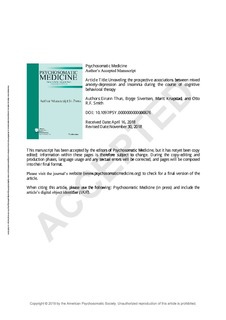| dc.contributor.author | Thun, Eirunn | |
| dc.contributor.author | Sivertsen, Børge | |
| dc.contributor.author | Knapstad, Marit | |
| dc.contributor.author | Smith, Otto Robert Frans | |
| dc.date.accessioned | 2020-03-03T13:13:44Z | |
| dc.date.available | 2020-03-03T13:13:44Z | |
| dc.date.created | 2019-06-20T15:34:29Z | |
| dc.date.issued | 2019 | |
| dc.identifier.citation | Psychosomatic Medicine. 2019, 81 (4), 333-340. | nb_NO |
| dc.identifier.issn | 0033-3174 | |
| dc.identifier.uri | http://hdl.handle.net/11250/2644968 | |
| dc.description.abstract | Objective
Previous studies have suggested that there is a reciprocal relationship between anxiety/depression and insomnia. However, little is known about the prospective relationships between these constructs across the course of cognitive behavioral therapy (CBT). The aim of the study was to examine these relationships in clients who received short-term CBT in a primary care setting.
Methods A total of 653 clients (mean [SD] age = 37.8 [12.9], 26.4% men) with mild to moderate levels of anxiety and depression and a treatment duration of at least 7 weeks were included for analyses. The clients completed questionnaires measuring mixed anxiety-depression (MAD – Patient Health Questionnaire Anxiety and Depression Scale) and insomnia (3 items derived from the Karolinska Sleep Questionnaire representing core DSM-V criteria) on a session-to-session basis. The data were analyzed using latent growth curve models and random intercept cross-lagged panel models.
Results The results of the latent growth curve models showed that there was a significant decrease in both MAD (cubic slope; B = .002, p < .001, quadratic slope; B = .036, p < .001, linear slope; B = −.205, p < .001) and insomnia (linear slope; B = −.080, p < .001) across treatment. A strong correlation (r = .838, p < .001) between the linear slopes indicated co-occurring change processes. The cross-lagged panel model showed that insomnia significantly predicted MAD at the subsequent measurements (B = .190, p < .001), but not vice versa (B = .252, p = .343).
Conclusions Changes in MAD and insomnia are co-occurring processes during the course of CBT. Changes in insomnia predicted prospectively changes in MAD, but not vice versa. Targeting insomnia in the context of brief CBT in clients with mild to moderate anxiety and depression may therefore further reduce not only symptoms of insomnia but also symptoms of anxiety and depression. | nb_NO |
| dc.language.iso | eng | nb_NO |
| dc.publisher | Lippincott, Williams & Wilkins | nb_NO |
| dc.title | Unravelling the prospective associations between mixed anxiety-depression and insomnia during the course of cognitive behavioral therapy | nb_NO |
| dc.type | Journal article | nb_NO |
| dc.type | Peer reviewed | nb_NO |
| dc.description.version | acceptedVersion | nb_NO |
| dc.source.pagenumber | 333-340 | nb_NO |
| dc.source.volume | 81 | nb_NO |
| dc.source.journal | Psychosomatic Medicine | nb_NO |
| dc.source.issue | 4 | nb_NO |
| dc.identifier.doi | 10.1097/PSY.0000000000000676 | |
| dc.identifier.cristin | 1706531 | |
| dc.description.localcode | © 2019. This is the authors' accepted and refereed manuscript to the chapter. Locked until 1.5.2020 due to copyright restrictions. The final authenticated version is available online at: http://dx.doi.org/10.1097/PSY.0000000000000676 | nb_NO |
| cristin.unitcode | 194,65,35,0 | |
| cristin.unitname | Institutt for psykisk helse | |
| cristin.ispublished | true | |
| cristin.fulltext | postprint | |
| cristin.qualitycode | 2 | |
